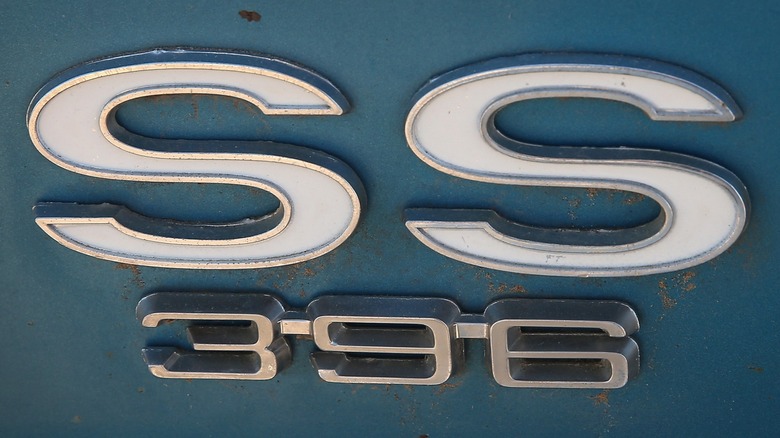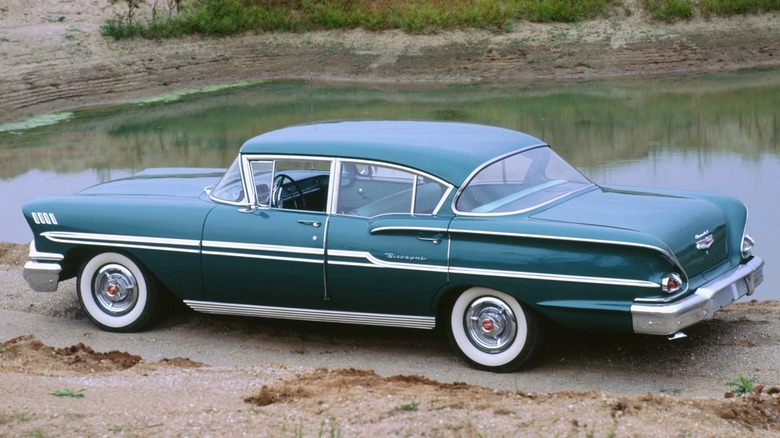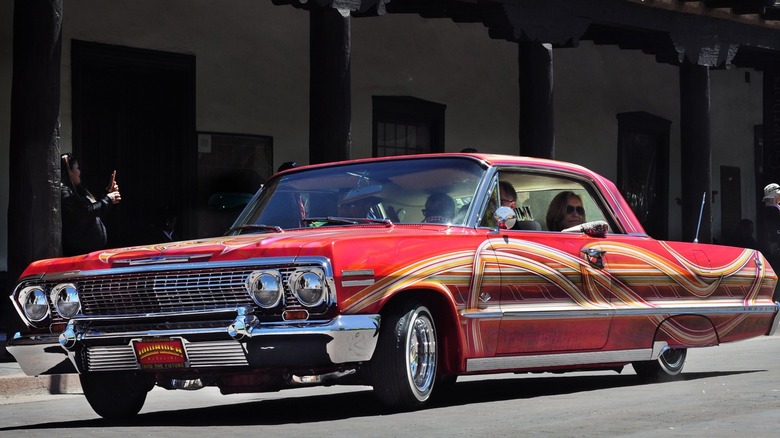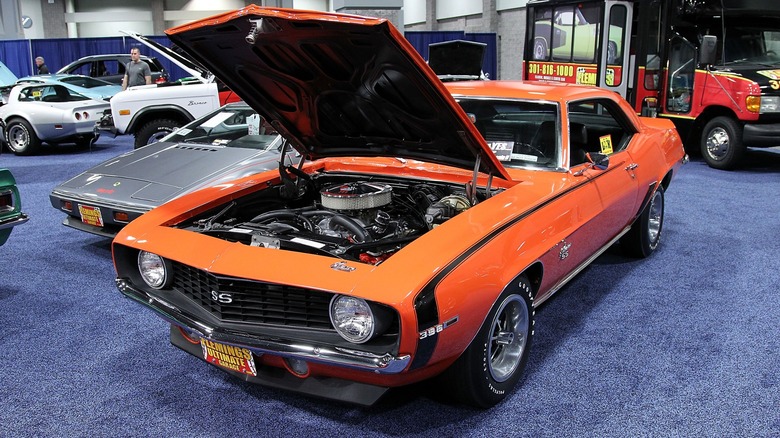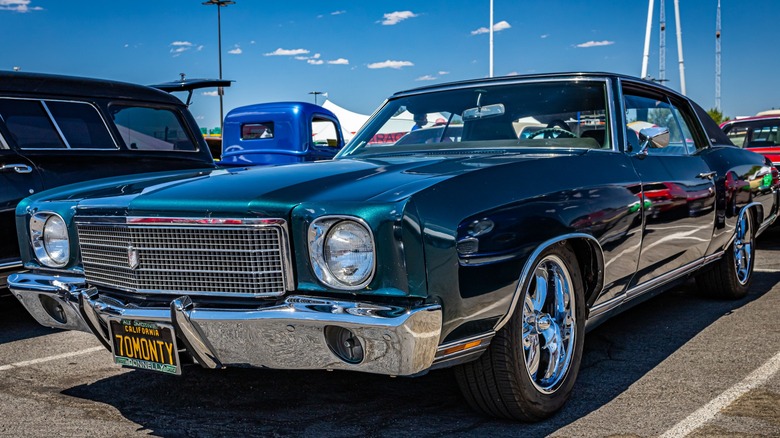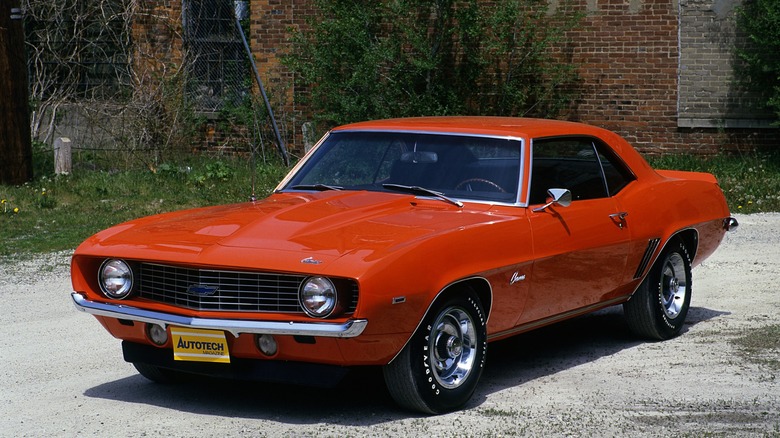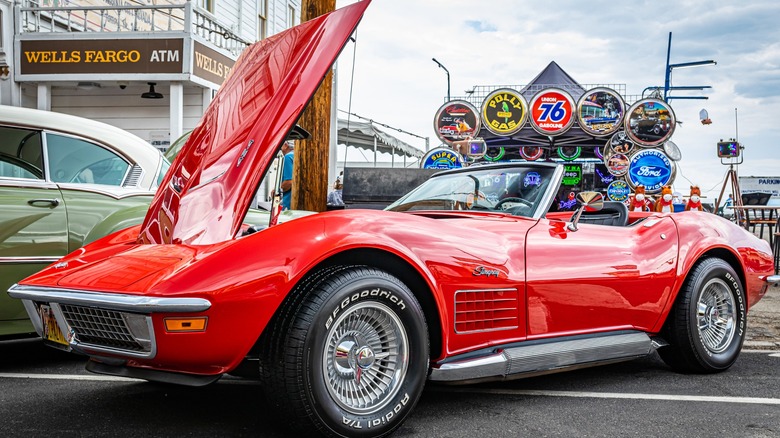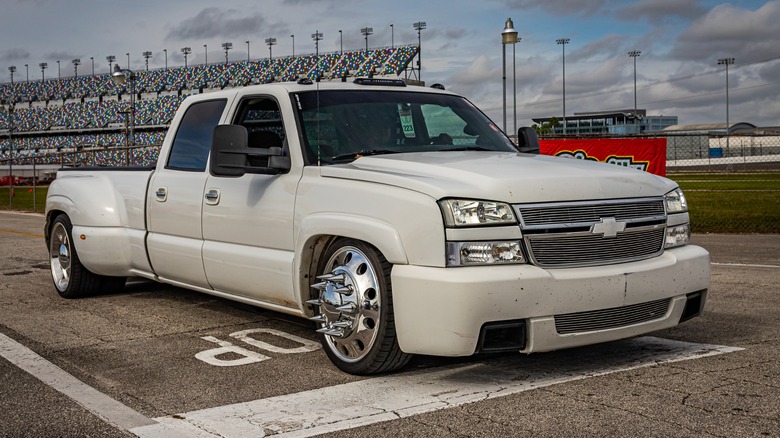Everything To Know About The Chevrolet Big Block Engine Family
As Chevrolet's lineup of cars and pickup trucks grew through the 1950s, the need for more powerful engines also grew, leading to the genesis of the Chevy big block engine family. Over the years, many familiar badge numbers have emblazoned the front grilles and tail ends of Chevrolet's most popular production hot rods. Two of the most popular are the 396 and 454. While those are indeed familiar big-block Chevy displacements, they do not represent the beginning nor the end of the Bow-Tie big-block family tree.
One of the primary reasons 396 and 454 big block Chevy first spring to many people's minds is their widespread usage in Chevelles, pickup trucks, and Corvettes. However, big-block Chevy engines have been used in many other motorized vehicles, including heavy-duty box trucks, school buses, motorhomes, and boats.
If the story doesn't begin with the 396 or end at the 454, what's missing? Let's dig into Chevrolet's big-block roots and trace the family tree through the years.
What was Chevrolet's first production big block engine?
Chevrolet's first production big-block, commonly known as a W engine, began powering its larger cars and pickup trucks for the 1958 model year and continued through 1964 in some applications. The origin of the W name falls into two camps. One side argues that the W comes from the wavy shape of the valve cover seating area. At the same time, the other side insists the letter W refers to the code name engineers used during its development along with X and Y, which Chevy dropped before production.
The first W big block featured a 348-cubic-inch displacement, cylinder heads without combustion chamber relief, and head mounting surfaces milled 16 degrees off square to the camshaft centerline. The 348's dimensions included 4.125-inch diameter cylinder bores and 3.25 inches of crankshaft stroke.
The off-square cylinder head deck created a wedge-shaped combustion chamber designed to swirl the fuel-air mixture inside the cylinder. This swirl allowed the mixture to burn uniformly under higher compression without damaging detonation, increasing engine torque.
Chevrolet offered several variations of the 348 big block during its brief tenure. The base variant, the Turbo-Thrust, used a four-barrel carburetor to achieve up to 250 horsepower. The Super Turbo-Thrust model received an arrangement of three two-barrel carburetors, dubbed "Tri-Power," good for 280 horsepower.
In 1958, the Special Turbo-Thrust, the third option, used a higher-flowing four-barrel carburetor to achieve 305 horsepower. Still, additional high-output treatment raised its power to 320 horses in 1959-1960 and 340 in 1961. The Special Super Turbo-Thrust 348 big block featured the Tri-Power carburetor setup on top of the Special Turbo-Thrust's enhancements to produce 315 horsepower in 1958, while the 1959-1960 HO option made 345 hp and the final model produced 350 horsepower in 1961.
Chevrolet's second big block W engine, the 409
Following the success of the 348, Chevrolet had only one reasonable choice: make it bigger. The result was the 409-cubic-inch big block, used from 1961 to 1965, featuring the same W block design. The 409 big block gained 61 cubic inches over its predecessor thanks to larger 4.31-inch diameter cylinder bores and a crankshaft stroke lengthened to 3.5 inches.
Displacement isn't the only metric by which the 409 beats the 348; it also has larger intake and exhaust valves, a solid lifter camshaft, forged aluminum pistons, and an 11:1 compression ratio. Equipped with a single Carter AFB four-barrel carburetor, the 1961 409 produced 360 horsepower and rose to 380 hp in 1962.
1962 saw the addition of the dual four-barrel Carter AFB carburetor setup on an aluminum intake manifold, bringing the power rating up to 409 horsepower. It's also the year the Beach Boys recorded their hit song, 409.
In 1963, Chevrolet offered a slightly de-tuned four-barrel Rochester carbureted 409 with hydraulic lifters and a 10:1 compression ratio generating 340 horsepower. During its last two years of service, the 409 came in single or dual Rochester carb versions with mechanical camshaft lifters and 11:1 compression ratios rated at 400 and 425 horsepower, respectively.
The big block 396 Chevrolet engine
Chevrolet replaced the W engine with the new Mark IV design in 1965. The first iteration, with a 396-cubic-inch displacement, was found primarily in Chevelles and Corvettes from 1965 to 1970. However, in 1968 and 1969, Chevy Novas and Chevy IIs also used the 396.
Featuring 4.094-inch cylinder bores and a 3.76-inch crankshaft stroke, the 396, with 11:1 compression ratios and an 800-cubic-feet-per-minute (CFM) four-barrel Holley carburetor offered either 375 with hydraulic lifters in the Chevelle or 425 horsepower with solid lifters in the Corvette. Some evidence suggests the two versions were actually closer in horsepower, so Chevrolet measured the Chevelle's 396 at a lower rpm than the Corvette's to gain a marketing advantage over the cheaper Chevelle.
Other 396 variants include those equipped with four-barrel Holley Q-jet carburetors and 10.25:1 compression ratios rated from 325 to 360 horsepower. A rare two-barrel carburetor-equipped version with a 9:1 compression ratio and 265 horsepower was also available in 1969.
Chevy 396 big block spin-offs
With the 396's success, variations of its design are not surprising. For example, the big-block 366 featured the same 3.76-inch crankshaft stroke as the 396 but smaller 3.935-inch cylinder bores and a taller deck height. The 366 was designed to provide generous low-end torque, primarily used in medium-duty trucks and school buses from the mid-1960s to 2004.
The 402-cubic-inch big block is another 396 variation offered by Chevrolet from 1970 to 1972. However, the 402 had an identity crisis. Due to its popularity, Chevrolet kept the 396 badging on 402-equipped muscle cars, called it the 402 when used in pickup trucks, and called it the Turbo-Jet 400 in its larger cars.
The 402, essentially a 396 with 0.030-inch larger cylinder bores, featured a 10.25:1 compression ratio in 1970, good for 330 horsepower. For 1971, the 402's compression ratio fell to 8.5:1, lowering its horsepower to 300. By 1972, net horsepower ratings fell to 210 or 240, depending on whether the vehicle had single or dual exhaust.
The history of Chevrolet's big block 427
The first 427-cubic-inch big-block Chevrolet engine produced in 1962 and 1963 used the 1960s 409 W engine design. In its short production run, only 50 complete 427s were produced for use in the 1963 Impala Sport Coupe, with another 20 partial engines for spare parts. The early 427 featured a 4.31-inch cylinder bore, 3.65-inch stroke, and 13.5:1 compression ratio. Equipped with dual four-barrel Carter AFB carburetors mounted on a two-piece high-rise aluminum intake manifold, the first-generation big block 427 produced 430 horsepower.
The second generation 427, based on the Mark IV engine design, was built between 1966 and 1969. The Mark IV 427 used a 4.25-inch cylinder bore and 3.76 inches of crankshaft stroke to achieve its displacement. One version featuring a 10.25:1 compression ratio generated 390 horsepower with a single four-barrel carburetor or 400 hp with the Tri-Power carb setup. Another version with 11:1 compression and an aggressive solid lifter camshaft made 425 or 435 horsepower, depending on its carburation.
The Gen-II 427 was available for full-sized Chevrolets like the Impala, Bel Air, and Biscayne. However, its most notable installations include Corvettes, COPO (Central Office Production Order) Chevelles, and COPO Camaros, especially those receiving Yenko Supercar conversion.
The big block Chevy 454
Chevrolet introduced its first big block 454 in 1970 for the Corvette and as an option for mid- and full-size cars until 1976. With a 4.25-inch cylinder bore and 4-inch stroke, the 1970 LS-5 454-equipped Corvette produced 390 horsepower, while the LS-6 made 450 hp thanks primarily to the 800 CFM Holley four-barrel carburetor.
1971 saw the LS-5 horsepower drop to 365 while the LS-6 fell to 425. The change from gross to net horsepower reporting lowered the 454 Corvette's ratings to around 270-275 net horsepower from 1972 to 1974. While some of the perceived loss was due to the change in horsepower reporting from gross to net, the 454 never returned to its full potential in production vehicles.
Following a brief hiatus from production vehicles, the Mark IV L19 454 returned to Chevrolet's pickup trucks in 1987 with electronic fuel injection. The Chevy 454SS pickup truck is the most performance-oriented offering of that period, with 230 net horsepower.
Fifth-generation 454 big block Chevrolet engines produced from 1991 to 1995 feature improved designs for the rear main seal, oil passages, valve covers, and front covers. However, horsepower ratings remained low at 230 hp due to restrictive intake and exhaust ports in the cylinder heads.
The Gen VI Vortec 7400 truck engine, the last of the 454s, was produced from 1996 to 2000. It delivered 290 net horsepower thanks to its hydraulic roller cam lifters, multiport fuel injection, and electronic powertrain control module (PCM).
The 8.1-liter 496-cubic-inch big block Chevrolet engine
The last big block in Chevrolet's lineup, the Gen VII 8.1-liter Vortec, displaced 496 cubic inches using the same 4.25-inch cylinder bore as the 454 but with a longer 4.37-inch crankshaft stroke. Thanks to its free-flowing cylinder heads, intake and exhaust manifold ports, and better engine control electronics, the 8.1 Vortec quickly surpassed the outgoing 454's performance ratings.
Power ratings for 8100 Vortec-equipped 2001 to 2007 heavy-duty pickups and SUVs come in at 340 hp with 455 lb-ft of torque. While the 50 hp increase over the old 454 is nice, the new engine also delivers more power at lower rpm, making it an excellent choice for towing heavily loaded trailers.
The 8.1-liter Vortec was used in boats, motorhomes, and Kodiak chassis/box trucks, such as 26-foot U-haul trucks, until 2010. Nowadays, the only option for purchasing an 8100 Vortec is an aftermarket crate engine or an engine rebuilder.
